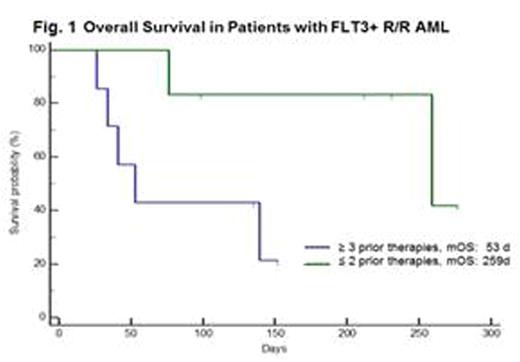Abstract

Background: Crenolanib is a novel, type I, oral pan-FLT3 inhibitor with in vitro activity against FLT3-ITD and FLT3-tyrosine kinase domain (TKD) mutations. Crenolanib has a half-life of 6-8 hrs and does not accumulate after chronic dosing. As a single agent, an overall response rate (ORR) of 30% (CR/CRi 19%, PR 12%) has been reported among patients (pts) with multiply relapsed/refractory (R/R) AML pts with FLT3 mutations despite sixty-five percent of the patients having prior exposure to FLT3 inhibitors. We report data from the first 13 pts with R/R FLT3+ AML treated with salvage idarubicin (Ida) and high-dose ara-C (HiDAC) followed by crenolanib.
Design: Pts received Ida (12 mg/m2 for 3d) with HiDAC (1.5 g/m2/d over 3 hrs for 4d or for 3d if >60y), followed by crenolanib starting on d5 and continued until 72 hrs. prior to next chemotherapy regimen. Standard rolling-6 design was implemented with dose escalation of crenolanib as follows: 60 mg TID (dose level 1), 80 mg TID (dose level 2), and 100 mg TID (dose level 3). Responding pts were eligible to proceed to allogeneic stem cell transplant (allo-SCT) or receive consolidation with ara-C (750 mg/m2 for 3d) and Ida (8 mg/m2 for 2d) followed by crenolanib at the same dose received during induction. Patients could then continue on maintenance with crenolanib. Post-SCT crenolanib maintenance therapy was not allowed.
Results: To date, all 3 dose escalation cohorts have been completed, which included 13 pts (11 males, 2 female) with a median age of 51 yrs (range 19-73). All pts had R/R FLT3+ AML. 6/13 pts had relapsed after 1 or 2 prior AML therapies, with the remaining 7 pts having 3-8 prior AML therapies (allo-SCT in 3). Nine pts had received prior FLT3 inhibitors including sorafenib (n=7), quizartinib (n=2), and E6201 (n=2). Nine pts had a FLT3-D835 kinase domain mutation, of which 4 pts also had FLT3-ITD; the remaining 4 pts had FLT3-ITD alone. Conventional cytogenetic testing included: normal karyotype (n=4; 31%), miscellaneous (n=5; 36%), and complex (n=4; 31%). Besides FLT3, multiple other leukemia-associated mutations were present at baseline: NPM1 (36%), DNMT3A (36%), NRAS/KRAS (27%), WT1 (18%), TET2 (18%), RUNX1 (18%), IDH1 (9%), IDH2 (9%), and ASXL1 (9%).
No dose-limiting toxicities were observed at any of the dose levels explored and there were no dose reductions required. Non-hematologic adverse events assessed as possibly or probably related to crenolanib were all grade 1 in severity, including: nausea (n=2), vomiting (n=2), diarrhea (n=1), and abdominal pain (n=1). No deaths were attributed to crenolanib.
The ORR in 11 pts evaluable for response was 36% (1 CR, 3 CRi; 2 not evaluable because of early discontinuation of therapy). Among 6 pts who received ≤2 prior AML therapies, 4 pts (67%) achieved a CR/CRi (including 2 pts with prior exposure to FLT3 inhibitors). These remissions occurred in pts with FLT3-ITD (n=2), FLT3-D835 (n=1) and FLT3-ITD+FLT3-D835 (n=1) (Table 1). No CRs were seen in the 5 pts who had 3 or more prior therapies (including 3/5 who had received prior FLT3 inhibitors) before coming on study.
Three CRi pts have undergone allo-SCT: 1 pt (43/F) achieved CRi (with persistent FLT3-ITD) after 1 cycle and maintained remission with FLT3-ITD negativity for 6 months post allo-SCT, 1 pt (67/M) achieved CRi with FLT3-D835 negativity after 2 cycles and maintained remission for 3 months post allo-SCT, and 1 pt (58/M) achieved CRi after 1 cycle and relapsed 1.5 months post allo-SCT. One pt (73/M) achieved a full CR with FLT3 negativity and count recovery and is currently receiving crenolanib maintenance.
The median OS for all patients was 259d; median OS by prior therapies was 259d for pts with ≤ 2 prior therapies, and 53d for pts with ≥ 3 prior therapies (Figure 1).
Conclusions: Full doses of crenolanib (100 mg TID) can be safely combined with idarubicin and HiDAC in multiply relapsed/refractory FLT3+ AML. There is suggestion of clinical efficacy particularly among pts with only 1-2 prior therapies. This trial is being expanded to allow combination of full dose crenolanib with other standard salvage chemotherapies, including MEC (mitoxantrone, etoposide, cytarabine) and FLA(G)-IDA (fludarabine, cytarabine, idarubicin w/ or w/o G-CSF).
Konopleva:Calithera: Research Funding; Cellectis: Research Funding. Jabbour:ARIAD: Consultancy, Research Funding; Pfizer: Consultancy, Research Funding; Novartis: Research Funding; BMS: Consultancy. Daver:Sunesis: Consultancy, Research Funding; Otsuka: Consultancy, Honoraria; Pfizer: Consultancy, Research Funding; Kiromic: Research Funding; Ariad: Research Funding; Karyopharm: Honoraria, Research Funding; BMS: Research Funding. Wierda:Acerta: Research Funding; Novartis: Research Funding; Abbvie: Research Funding; Gilead: Research Funding; Genentech: Research Funding. Burger:Pharmacyclics: Research Funding. Eckardt:Arog: Employment, Equity Ownership. Cortes:ARIAD: Consultancy, Research Funding; BMS: Consultancy, Research Funding; Novartis: Consultancy, Research Funding; Pfizer: Consultancy, Research Funding; Teva: Research Funding.
Author notes
Asterisk with author names denotes non-ASH members.

This icon denotes a clinically relevant abstract



